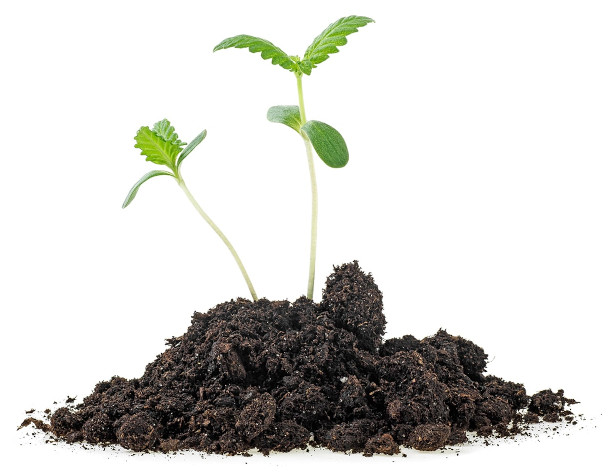Keeping your cannabis plants happy and healthy depends on how carefully you take care of your marijuana plant at every stage of its life. This is especially important in the younger stages of your plant’s life when they are at their most delicate stage.
When a cannabis seed germinates, it splits along the suture connecting the halves of its shell. Propelled by gravity, the seedling root grows rapidly, penetrating the soil until the root has sufficient leverage to hold the tray containing the two halves of the seed upright.
From this position, the two halves of the seedling leaves are unfolded to act as biological solar panels. Now gathering energy and starting a cannabis plant’s initial chlorophyll production, the tiny taproot sprouts hair-like feeder roots that expand outward to strengthen their grip on the soil.
In this article, we take a look at ways to protect your seedlings during their most delicate phase of life.
What is the seedling stage of Cannabis?
The most important thing at this stage is to simply pay attention and observe any development or change in the cannabis seed. When they germinate, the shells divide, releasing a white root within a few hours of dividing.
This seedling root will grow very quickly, moving downwards until it is deep enough to support the rest of the plant (namely the stem and seed coat).
The husk, now split in two, emerges from the ground and acts as a kind of makeshift pair of leaves – in other words, they absorb energy that can be used to produce chlorophyll in the plant. As the trunk grows upwards, you can be sure that more roots will grow downwards at the same time.

What are Cannabis Seedlings?
The first two leaves are completely unique and entirely different from future leaves that will grow on the plant and emerge from the center of the split seed coat. These leaves mark the beginning of more leaf growth.
Two lobed leaves then grow from the center of the seedling leaves. These two-lobed leaves are similar to chicken feet in that they have three leaves per leaf pair.
After the three-leaf leaves come two leaves with five individual leaves, and then two more with seven. Seven-petalled leaves are the ones that everyone recognizes as marijuana leaves.
If you could keep your marijuana plants healthy throughout the germination stage, they would most likely go through a very productive vegetative stage. Protecting your young plants is about more than survival: it’s about investing in your future harvest.
Read the Germinating Cannabis Seeds article for more info on germinating seeds.
This article covers the different elements of cannabis seedling care that you need to keep a constant eye on to ensure the well-being of your seedlings. These elements are shelter, water, nutrients, heat, and light.
You need to protect your young plants from more than just detection by the authorities.
Even if you live in a place where growing marijuana is legal, you still have to worry about protecting your seedlings.
You should keep your plants in a sheltered area such as a roof and protect them with a clear plastic dome or mini greenhouse.
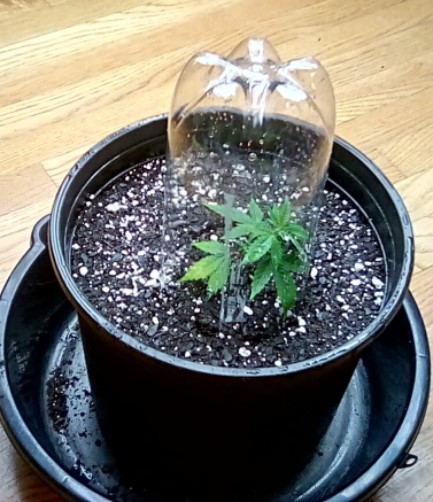
These domes can keep your seedlings from being eaten by insects, rodents, or other pests. They’re easy to make and cheap to obtain.
Simply cut a clear plastic bottle in half, then recycle the top half and keep the bottom half. You should cut small slits around the edges of this half to give your young plant some airflow.
Place the dome over your little weed plants and cover them completely. This has the added benefit of insulating your plant should an unexpected frost hit.
In addition to insulation and protection, your seedlings need the most important element on earth: water. You need to keep the soil and seedling moist constantly 24/7 and make sure they get plenty of sunlight.
If you live further north, you might have trouble with this, as your spring days are shorter than further south.
A big problem that outdoor growers can face is that their seedlings don’t get enough sunlight.
When this happens, the plant stretches higher and higher to get more sunlight, remains thin with few leaves, and then it’s too tall but weak to sustain itself longer.
If you have enough space and resources, you can grow your cannabis seeds in a closet at first. With the right equipment in this environment, you can give your young cannabis plants plenty of light (through grow lights) and enough energy to develop large, healthy leaves from the start.
Growing this way would also ensure that the stems of your cannabis plants don’t grow too long and weak; rather they will grow short and strong. This will help you avoid having to use sticks to stabilize large, weak trunks.
It should be mentioned that if you prefer your seedlings indoors, it will be necessary to transplant them later. Which comes with its own difficulties and safety concerns for your young plants. Ultimately, it depends on which option is best for you.
How much water do the young cannabis seedlings need?
A common problem that arises when trying to take care of a seedling is giving them too much water.
It’s actually less of a problem to do with too much water. Actually, it’s more to do with not enough oxygen reaching your plant’s roots.
This is most common with seedlings that are grown in containers since water can only flow as far as the walls of the container.
If your plants are over-watered, you will likely see symptoms such as drooping leaves. However, there are many ways to avoid this as long as you read on for a better understanding.
The situation or stage of your cannabis plant is the most important factor when it comes to how you over-watered your plants and how to fix or avoid the problem.
Overwatering cannabis seedlings
Is Your pot too big for your seeding?
As the tiny roots of a young plant can absorb much less water than their more mature counterparts. If you water as much as the container can hold, those delicate roots won’t be able to absorb it all.
This situation sometimes referred to as ” overpotting “, results in overwatering. How do you prevent this situation?
It is best to start your seedling’s life in a smaller container first. Once it has grown a considerable amount, you can transplant it into a larger container.
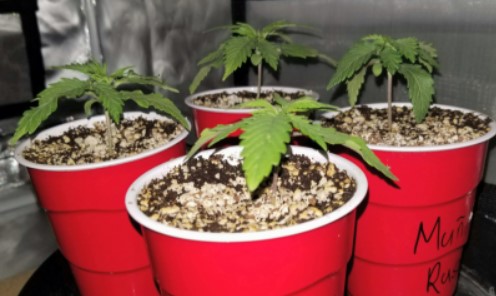
However, when it’s too late and you need to fix the problem, simply direct your watering to a specific area in the soil: a small circle around your plant. Once the top inch of soil is dry again, you can water again. After that, you can water normally again.
If you plan ahead well enough, you can have a separate container (pot)for each life stage of your cannabis plants. If your plants live in pots throughout the growing season, you need to know the size of your final container in advance.
In other words, you need to have a good idea of how big you want your plants to be. Because the roots grow faster when left in a container for a long time, fewer transplants (repotting) mean a larger plant (and therefore a larger container). Take this into account when planning your pot sizes.
Your pot is too small for your seeding
You can plant seedlings in very small individual containers, such as a small nursery pot. However, you cannot keep her locked up in a nursery pot forever, as her roots will quickly outgrow the small space.
If your plants are left in a small container for too long, they will become “root bound”. This means the roots have wrapped themselves around the outside of the cup, preventing water from escaping the inside.
Why is root binding so bad? It can lead to some pretty big problems, including overwatering, nutrient deficiencies, wilting of the plant, and more. You can avoid this problem by resizing the containers as often as necessary.
Poor drainage
If your plants’ container doesn’t have an efficient drainage system (ie holes in the bottom of the container and the right type of soil), overwatering quickly becomes a problem that could be fatal to your plants.
One way to prevent this is to grow your plants in soil that drains well from the start. Clay soils, for example, retain water and should therefore be avoided.
So you can start with a smaller container (pot)to avoid the problem mentioned above. Make sure your container has enough holes in the bottom for water to drain out.
If you notice that water isn’t draining as quickly as it should, you can add perlite to your soil to increase oxygenation and drainage. Don’t water your plants so often until you notice them drinking more, or try a smart pot instead of a regular pot.
If you follow these tips and are careful about watering your plants, you should be able to avoid overwatering them altogether.
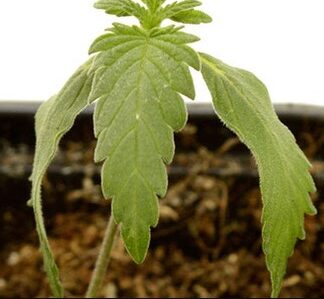
Lack of water
If you’re sure you haven’t watered your plants too often or too much and they’re drooping or wilting, the culprit could actually be a lack of water.
Sometimes people are aware of the common occurrence of over-watered seedlings, have overcompensated and therefore watered their plants less than necessary.
The roots of your plants need constant access to water. Plants lose the water they absorbed through their leaves in a process called transpiration. They do this by sucking the water out of the roots like a straw.
If this process continues and the roots below don’t get enough water, the plant will experience some serious problems.
If you notice your soil (earth)separating from the container it’s in, you probably have a water shortage.
When your soil is enriched with nutrients and your plants are deprived of water, the effects become even more devastating. Your plants will get a dark green colour and growths of a strange colour.
In this case, the only thing you can do is give your plants more water to restore their roots and start growing again. If they get enough water to combat this problem, they will likely be able to get through this situation.
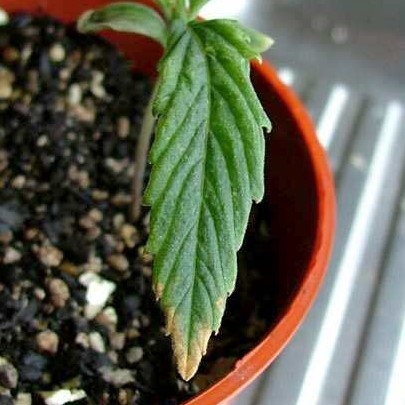
Overfeeding – Nutrient Toxicity Seedlings
Adding nutrients to your plants can also have its own problems. For example, giving your plants too high a dose of nutrients can lead to nutrient toxicity. The leaves of your cannabis plant will burn at the tips and darken.
Nutrient Toxicity can be caused by using “HOT SOIL” or a type of soil that is high in nutrients. As long as you water your seedlings adequately, they should be able to grow out of this nutrient toxicity that comes from using such soil.
Some soils are “slow releasers” like Miracle-Gro. Avoid these soils at all costs as they will not help your plant be healthier – it will rather make them even more susceptible to nutrient toxicity.
If you fertilize your seedlings when they are too young, they could get some sort of nutrient overdose. As long as your first soil mix(for the young plants) is of high quality, you should not worry about adding fertilizer for the first (4-5) weeks.
If you feed your plants a large amount of nutrients (fertilizer) at once, you could end up with nutrient toxicity in less than a day.
If you are using a fertilization schedule that comes with store-bought fertilizer, use only half the recommended dosage and see how the plants respond before adding more fertilizer.
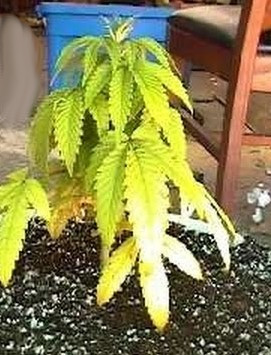
Nutrient deficiency
If you use the wrong kind of nutrients or buy a soil mix that is not suitable for cannabis seedlings, your plants could end up with a nutrient deficiency.
You can identify this problem by the yellowing of the leaves and wrinkled leaves starting to form on your plant.
They will eventually wither and fall off.
These leaves are on the bottom of the plant, but if they’re only on top, it’s probably not a nutrient deficiency.
Nutrient deficiencies always affect your older leaves first and the oldest are at the bottom of the cannabis plant.
You can avoid such problems by making sure your plants have the right kind of nutrients and by providing more nutrients when the plants are consuming their current soil (nutrients in the soil).
Growing your plants without soil (another medium) doesn’t mean you don’t need to provide nutrients.
Balance your pH
Problems could also arise if the soil is not kept at a balanced level of 6 – 7. Even if the right nutrients are present and the wrong, your plant could be nutrient deficient.
Watering your plants poorly could also have a nutrient-related effect on your plants.
Keeping your plants in a pot that is too small for them for too long will cause a nutrient deficiency to develop because the roots will take longer to function properly.
The ideal temperature cannabis seedling
The temperature should stay close to 20 – 23 degrees Celsius. But if it’s too hot, just move the lamp further away from the plant. Exposing your seedlings to high temperatures will cause the leaves to curl upward and form a canoe shape.
You can solve this problem simply by lowering the temperature.
How much light to use for Cannabis Seedlings
If you are germinating your seeds indoors it is best to place your seedling in containers. Fluorescent lights don’t give off much heat so you can place them close to the plants (2 to 4 inches).
Ensure that the fluorescent lights are cycled 18 hours on and 6 hours off.
When using HPS grow lights, place them as close to the seedlings as possible. But do not allow the temperature of the plants to exceed 30 degrees Celsius.
If you germinate the plants outdoors, it’s different. It is certain that sunlight is most important when your plants are starting to sprout.
Don’t be afraid to give them too much light. It’s almost never enough, as long as you keep your plants’ other needs in check. (ie keep the soil consistently moist).
It will be obvious if you don’t give your plants enough light. The trunks (stems) are slightly white, tall and thin. Basically, the plants are trying to get as much sunlight as possible.
That is, every plant has something called the “light saturation point.” or that point at which the plants cannot utilize all the light they are exposed to. As long as you keep your lighting reasonable, your plants probably won’t reach their light saturation point.
Should this point actually be reached, it will be a waste of light, electricity and time. In fact, if a plant gets too much light, it won’t grow as fast as there’s no point in growing taller to receive more sunlight when it’s already too much light.
An easy way to reduce the amount of light your plants receive is to elevate your lights, moving them away from the plants. If they need more light, move the lamp closer. As simple as that!
Avoid stretching the seedlings
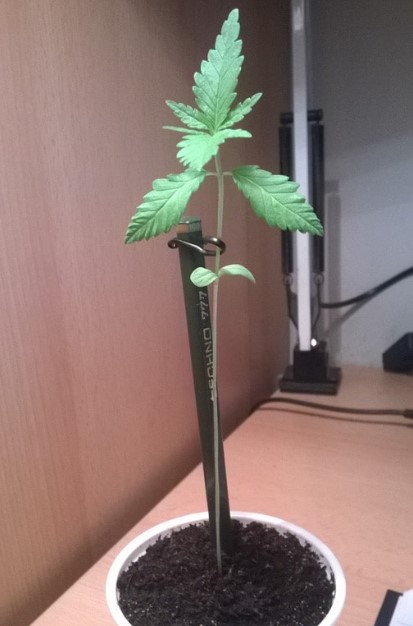
Stretched cannabis plants tend to be like this due to certain environmental factors.
Extended plants will not produce stout stems that can support multiple branches, buds, and leaves.
It is therefore important that the marijuana plants do not become too thin. A simple solution to this problem is to bend the trunk back and forth.
Although this could put a lot of stress on the plant, it forces the stem to tear slightly (in the fibres) and then regenerate and become stronger in that area (similar to humans’ muscles). This makes the trunks much more stable.
Other solutions to this problem include using an excess of blue light, keeping temperatures around 26°C, or making sure plants have all the light they need.
When the light becomes scarce, plants begin to stretch to reach for the light source.

